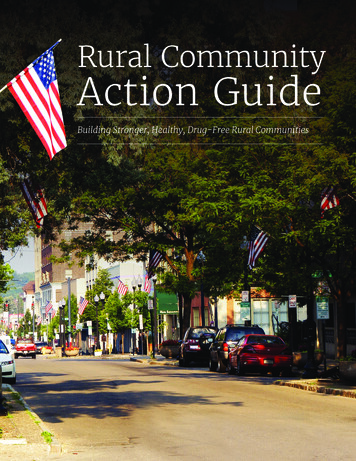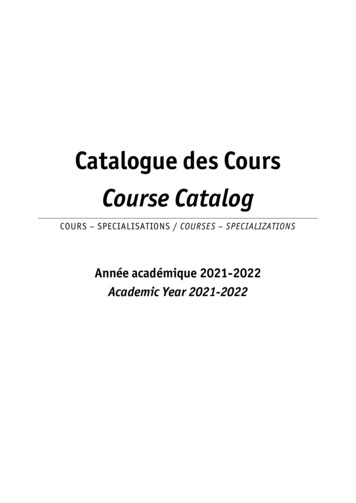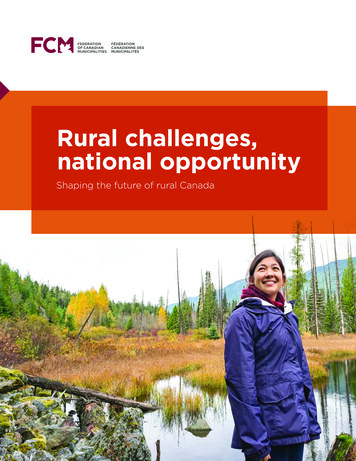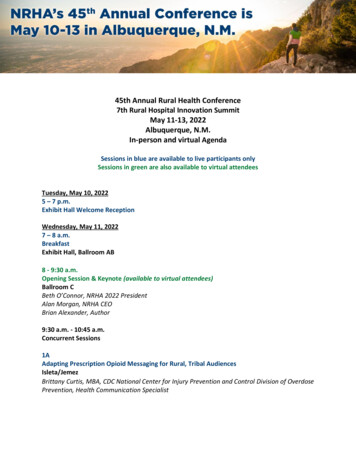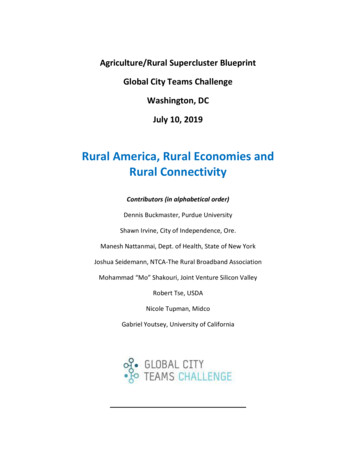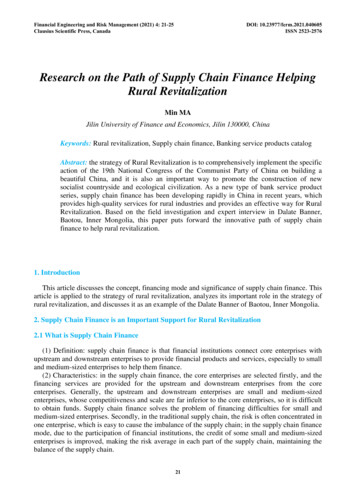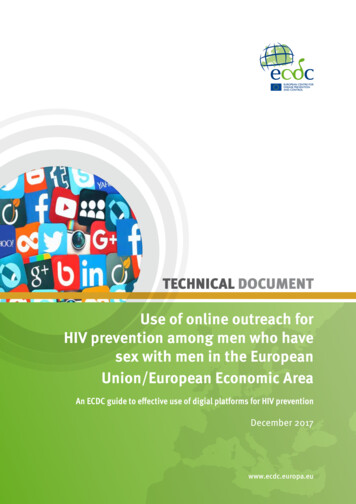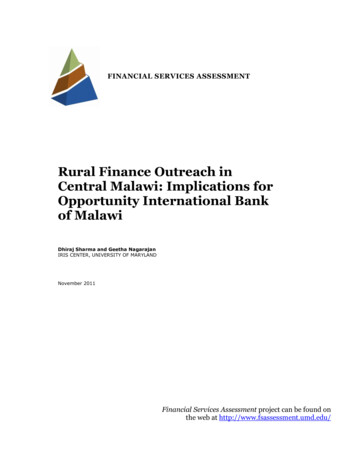
Transcription
FINANCIAL SERVICES ASSESSMENTRural Finance Outreach inCentral Malawi: Implications forOpportunity International Bankof MalawiDhiraj Sharma and Geetha NagarajanIRIS CENTER, UNIVERSITY OF MARYLANDNovember 2011Financial Services Assessment project can be found onthe web at http://www.fsassessment.umd.edu/
ABOUT THE AUTHORSABOUT THE PROJECTThe Financial Services Assessment project is designed toexamine the impact of financial services on the lives ofpoor people across the developing world. This project isfunded by the Bill & Melinda Gates Foundation, which iscommitted to building a deep base of knowledge in themicrofinance field. The IRIS Center at the University ofMaryland, College Park, together with its partner,Microfinance Opportunities, will assess a diverse range ofinnovations in financial services. The results of this projectwill shed light on the design and delivery of appropriatefinancial products and services for the poor and thepotential to scale up successful innovations to reach largernumbers of low-income households.FUNDINGThe Financial Services Assessment Project is funded by agrant from the Bill & Melinda Gates Foundation.Dr. Dhiraj Sharma is Program Specialist at the IRIS Centerwho is experienced in the design, implementation, monitoring,and evaluation of social programs using randomized controltrials, quasi-experimental designs, and non-experimentalmethods. He also has extensive experience in designing andimplementing large scale multi-topic household surveys andanalyzing large data sets in STATA. He recently designed,implemented, and evaluated a field experiment in Nepal wherehe studied the impact of financial incentives on students’academic outcomes. He also conducted an evaluation of theimpact of solar panels on income, livelihood, and agriculturalproductivity among rural households in Nepal. Dr. Sharmaholds a Ph.D. in Agricultural Economics from the departmentof Agricultural, Environmental, and Development Economics(AEDE) at the Ohio State University.Dr. Geetha Nagarajan is Associate Director at the IRISCenter, serving as Research Director, Economist andMonitoring and Evaluation Specialist. She designed anddirected this study in Malawi for the Financial ServicesAssessment project. Dr. Nagarajan is a highly experiencedresearcher, advisory assistance provider, and author of severalpeer reviewed publications. She has worked in 21 developingcountries in Asia, Africa and Eastern Europe. Dr. Nagarajanhas evaluated economic development programs, andconducted field based research to identify causes of poverty todesign policy and programs to address them, especially inconflict and disaster affected environments. An expert in smalland micro and small enterprise development, and rural andmicrofinance, she has a wide range of experience indeveloping, measuring, and implementing activities to ensureprogram effectiveness to reach the target population.ABSTRACTREPORT SERIESThis report is part of a series that will be generated by theFinancial Services Assessment project. The reports aredisseminated to a broad audience including microfinanceinstitutions and practitioners, donors, commercial andprivate-sector partners, policymakers, and researchers.CONTACT IRISIRIS CenterUniversity of MarylandDepartment of Economics3106 Morrill HallCollege Park, MD 20742 (USA)E-mail:Phone:Fax:Web:info@iris.umd.edu 1.301.405.3110 1.301.405.3020www.iris.umd.eduCONTACT MICROFINANCE OPPORTUNITIES1701 K Street NWSuite 650Washington, DC 20006 (USA)E-mail:Phone:Fax:Web:info@mfopps.org 1.202.721.0050 ng data gathered from a panel of 2,006 households by theIRIS Center at the University of Maryland in 2008 and 2010,we study the outreach of the mobile bank run by theOpportunity International Bank of Malawi (OIBM) in centralMalawi. Our analysis shows that the breadth of outreach ofOIBM increased in rural Malawi within a short period of itsentry into the competitive financial landscape where manyfinancial institutions offered similar products and services.OIBM also attracted more female borrowers compared to otherformal institutions, and it was able to service its depositors atlower transaction costs compared to savers with other formalinstitutions, which was mostly due to reduction in direct costsof travel. However, the uptake of OIBM’s services among thepoor and those living far from the mobile bank stops wasmodest. We find that the innovative efforts of OIBM to bringthe bank closer to the rural population, offer services withbetter terms and conditions, and provide adequate informationon its services paid off well. In order to sustain its currentoutreach and grow further, OIBM needs to combine its firstmover advantage with a continual improvements in itsproducts, services, delivery mechanisms and informationdissemination methods and its worldwide experience inserving women and the poor.ACKNOWLEDGEMENTSThe authors would like to thank the survey team in Malawi,Wadonda Consult, for their hard work in gathering data, andOpportunity International Bank of Malawi (OIBM) for itscooperation at various stages to conduct the study. We highlybenefitted by the field work conducted in Malawi by JeffreyFlory, Sarah Adelman and Arthur Shaw at the IRIS Center.We thank the FSA staff at the IRIS Center and MFO for theirvaluable comments that helped revise the paper. All errorsare attributable to the authors.1Rural Finance Outreach in Central Malawi: Implications for Opportunity International Bank of Malawi
TABLE OF CONTENTSTABLE OF CONTENTS .2EXECUTIVE SUMMARY .6BREADTH OF OUTREACH . 7DEPTH OF OUTREACH . 7COST OF OUTREACH . 9IMPLICATIONS FOR OIBM . 10INTRODUCTION . 12STUDY METHODOLOGY . 15SURVEY INSTRUMENT. 15SELECTED SAMPLE CHACTERISTICS . 16MEASURING OUTREACH . 18BREADTH OF OUTREACH . 19DEPTH OF OUTREACH .25POTENTIAL CLIENTS OF OIBM, FORMAL INSTITUTIONS AND INFORMAL AGENTS . 32COST OF OUTREACH .35TRANSACTION COSTS OF OPENING A SAVINGS ACCOUNT . 36TRANSACTION COSTS OF DEPOSITING INTO A SAVINGS ACCOUNTS . 38TRANSACTION COSTS OF WITHDRAWING FROM A SAVINGS ACCOUNT . 39DRIVERS OF TRANSACTION COSTS FOR DEPOSITORS. 40TRANSACTION COSTS OF APPLYING FOR A LOAN . 42TRANSACTION COSTS OF LOAN REPAYMENT . 43DETERMINANTS OF TRANSACTION COSTS FOR BORROWERS . 44CONCLUSION AND IMPLICATIONS . 46IMPLICATIONS FOR OIBM . 46REFERENCES . 482Rural Finance Outreach in Central Malawi: Implications for Opportunity International Bank of Malawi
ACRONYMSBMGFBill & Melinda Gates FoundationCGAPConsultative Group to Assist the PoorFBPAsField-Based Promotional AssistantsFINCOOPFinance Cooperative Ltd.HFIAPHousehold Food Insecurity Access PrevalenceHFIASHousehold Food Insecurity Access ScaleMFIsMicrofinance InstitutionsMISManagement Information SystemsMKMalawi KwachaMRFCMalawi Rural Finance CompanyNGONon- Governmental OrganizationOIBMOpportunity International Bank in MalawiPATPoverty Assessment ToolPPPPurchasing Power ParitySACCOsSavings and Credit Cooperatives3Rural Finance Outreach in Central Malawi: Implications for Opportunity International Bank of Malawi
INDEX OF TABLESTable 1: Baseline Characteristics of Sampled Households in the Panel Sample .17Table 2: Households with New Savings Accounts . 22Table 3: Households with New Outstanding Loans . 23Table 4: Proportion of New Savers by Type of Savings Accounts . 25Table 5: Proportion of New Savers and Borrowers by Occupation . 26Table 6: New Savers and Borrowers by Call Centers . 29Table 7: Poverty Status of New Savers and Borrowers . 30Table 8: Potential Clients of OIBM, Other Formal Institutions and Informal Agents: Log OddsRatio from Multinomial Logit Regression (Reference Group New Informal Users). 33Table 9: Demand Side Components of Transaction Costs . 36Table 10: Median Transaction Costs to Open a Savings Account (MK) . 38Table 11: Median Transaction Costs to Deposit into a Savings Account (MK) . 39Table 12: Median Transaction Costs to Withdraw from a Savings Account (MK) .40Table 13: OLS Estimates of Transaction Costs for Depositors with OIBM, Other FormalFinancial Institutions and Informal Agents (Reference Group New Informal Savers) . 41Table 14: Median Transaction Costs to Apply for a Loan (MK) . 43Table 15: Median Transaction Costs to Repay a Loan (MK) . 44Table 16: OLS Estimates of Transaction Costs for Borrowers with OIBM, Other FormalFinancial Institutions and Informal Agents (Reference Group New Informal Borrowers) . 454Rural Finance Outreach in Central Malawi: Implications for Opportunity International Bank of Malawi
INDEX OF FIGURESFigure 1: Access to Financial Services across Southern, Eastern, and Western Africa . 12Figure 2: Number of Households with Savings Account and Outstanding Loan. 19Figure 3: Number of Savings Account and Market Share of Savings Accounts .20Figure 4: Share of Outstanding Loans (by type of lender) . 22Figure 5: Proportion of New Savers and Borrowers from Information and Non InformationAreas . 24Figure 6: Gender of New Savers and Borrowers . 26Figure 7: Educational Attainment and Literacy Status of New Savers and Borrowers . 27Figure 8: Distance of New Savers and Borrowers from the Nearest OIBM Mobile Bank Service. 28Figure 9: Food Security Status of New Savers and Borrowers . 30Figure 10: Average and Median Savings Balance for New Savers (MK) . 31Figure 11: Average and Median Outstanding Loan Balance for New Borrowers (MK) . 32Figure 12: Transaction Costs to Open a Savings Account as Fraction of Savings Balance . 37Figure 13: Transaction Costs to Apply for a Loan as Fraction of Loan Size . 425Rural Finance Outreach in Central Malawi: Implications for Opportunity International Bank of Malawi
EXECUTIVE SUMMARYThe use of formal financial services in Malawi is found to be limited due to at least fourreasons. First, although a majority of the Malawian population lives in rural areas, formalfinancial institutions are mostly located in urban and semi-urban areas, physically distantfrom the rural households. Second, rural households face obstacles to opening a formal bankaccount since most formal institutions have account terms, such as relatively large minimumbalances, that set formal financial services out of reach of rural populations. Third, manybanks also require formal identification cards such as a passport or other government ID thatrural populations may not have and may find prohibitively expensive to procure. Finally,these households lack adequate information regarding access to and use of formal financialservices.In order to relax some of the aforementioned constraints to the access and use of formalfinance in rural Malawi, the Bill & Melinda Gates Foundation (BMGF) provided funding in2007 to Opportunity International Bank in Malawi (OIBM) to purchase a mobile bank toserve unbanked rural areas. The mobile bank is a roving bank capable of providing a fullrange of financial services. The catchment area for the OIBM‘s mobile bank included sixtrading centers along a predetermined route across Lilongwe, Mchinji, and Dedza districts incentral Malawi. Of the six trading centers, four did not have prior banking facilities while theother two were previously served by other brick and mortar bank branches. OIBM alsodeveloped products suitable for rural clients served by the mobile bank by reducingidentification requirements, reducing minimum balance for savings accounts, and waivingcollateral requirements for loans. Please see box 1 for detailed information on OIBM and themobile van. The mobile bank went in operation in August of 2007.IRIS, in collaboration with OIBM, designed an intense information campaign to disseminateinformation about OIBM and to increase its outreach. Between April 2008 and December2010, Field-Based Promotional Assistants (FBPAs) visited villages, made contact withpotential clients, and disseminated information about the products and services offered byOIBM. The information campaign was conducted in a randomly selected subset of 56enumeration areas while households in the remaining enumeration areas receivedinformation regarding OIBM‘s product only via mass media like radio.This paper, using data gathered from a panel of 2,006 households by the IRIS center at theUniversity of Maryland from 2008 and 2010, examines the impact of the mobile van onfinancial outreach of OIBM relative to other formal financial institutions, and informalsources. We define outreach in terms of number and types of clients reached by financialinstitutions, especially the poor, and the costs of serving them. We do not consider cash keptat home and in-kind loans and savings in the analysis.We address the following issues to draw implications for OIBM: Has outreach of OIBM increased relative to that of other formal financialinstitutions? If so, has it been reflected in breadth, depth and costs of its outreach?What factors facilitated the observed trends in breadth, depth and costs of outreachof OIBM relative to informal and other formal providers? More specifically:o Did the intense information campaign conducted by OIBM increase itsoutreach?o Did OIBM‘s products and services incorporate vulnerable populations into itsclientele?o Did OIBM‘s mobile bank reduce the transaction costs of access to and use ofservices?6Rural Finance Outreach in Central Malawi: Implications for Opportunity International Bank of Malawi
Analysis of data from sampled households shows the following:BREADTH OF OUTREACHa.Use of financial products and services was prevalent and increasing. 35percent of the households at baseline (705 of 2,006) and 44 percent at endline (889 of 2,006) had at least one savings account or an outstanding loan.b. There were more borrowers than depositors. At end line, 34 percent ofsampled households (688 of 2,006) had at least one outstanding loan while18 percent of households (363 of 2,006) had at least one savings account.c.A vast majority of the savings accounts were held with formal institutions.About 87 percent (229 of 264) and 85 percent (404 of 475) of the savingsaccounts were held with formal institutions at baseline and end linerespectively.d. There was an increase in the number of savings accounts, primarily due toOIBM. The number of savings accounts increased from 264 in 2008 to 475 in2010, an 80 percent increase. Increase in savings accounts with OIBM aloneconstitutes approximately 40 percent of the total increase in the number ofsavings accounts. OIBM‘s market share of savings accounts increased from10 percent at baseline (26 of 264) to 23 percent at end line (108 of 404).e.A vast majority of loans were sourced with informal agents. 82 percent ofthe outstanding loans (525 of 641) at baseline and 85 percent of theoutstanding loans at end line (743 of 864) were sourced with informal agents.f.Households were much more likely to use formal institutions for savingthan borrowing. While more than 85 percent of savings accounts were heldwith formal institutions, less than 20 percent of loans were sourced fromformal institutions.g.The intense information campaign increased the outreach of OIBM. OIBMadministrative data collected from the Management Information Systems(MIS) database shows that approximately two thirds (933 of 1,422) of thenew OIBM clients that joined between April 2008 and May 2009 originatedfrom intense information campaign areas. 72 percent of new savers (63 of88) in the survey sample came from areas covered by the intense informationcampaign.h. The intense information campaign also had a positive spillover effects onthe uptake of financial products offered by other providers. Approximately56 percent and 58 percent of new savers with other formal institutions andinformal agents belonged to information areas.DEPTH OF OUTREACHi.OIBM was more successful than other formal institution in attractingfemale borrowers, but less successful in attracting female depositors. 67percent (10 of 15) of new borrowers with OIBM were females while 52percent of new borrowers (47 of 91) with other formal institutions were7Rural Finance Outreach in Central Malawi: Implications for Opportunity International Bank of Malawi
females. On the other hand, 33 percent (29 of 87) and 48 percent (82 of 172)of new savers with OIBM and other formal institutions were females.j.Outreach of OIBM among females was higher among borrowers thandepositors. Among new OIBM savers, 33 percent were females (29 of 87)while 67 percent of the new OIBM borrowers (10 of 15) were females.k.Formal financial institutions attracted fewer farmers relative to informalagents. 89 percent of new savers with informal agents were farmers, while itwas 71 percent and 73 percent for OIBM and other formal institutionsrespectively. Similarly, 88 percent of new borrowers with informal agentswere farmers while the figures for OIBM and other formal institutions was 60percent and 76 percent respectively.l.New savers and borrowers with OIBM and other formal institutions wererelatively more educated and literate compared to new savers andborrowers with informal agents. Formal institutions often require clients tofill out forms and sign on terms and conditions before opening an account,which may have discouraged the illiterate and the uneducated to approachthe institutions for banking services.m. Geographic distance was not a major limiting factor for take up of savingsaccounts and loans with OIBM and other formal institutions. Nearly 44percent and 47 percent of new savers with OIBM and other formalinstitutions lived farther than seven kilometers from the nearest OIBMmobile van service center, and the pattern is also similar among newborrowers.n. OIBM’s roving van attracted residents living near the OIBM mobile bankservice centers that were not served by other banks. About 77 percent (68 of88) of new borrowers and 67 percent (10 of 15) of new savers with OIBMlived near OIBM service centers with no other banking services.o. Food secure households were relatively more likely to borrow or save withformal institutions. While 13 percent and 15 percent of new savers withOIBM and other formal institutions were food secure, only 6 percent of newsavers with informal agents were food secure. Similarly, 13 percent of newborrowers with OIBM and other formal institutions were food secure whilethe proportion among new borrowers with informal agents was 5 percent.p. Severely food insecure households were more likely to borrow or save withinformal agents. Among new savers with OIBM and other formalinstitutions, 25 percent and 27 percent of clients were severely food insecurewhile figure among new savers with informal agents was 33 percent. Thecontrast among new borrowers was starker: 20 percent, 33 percent and 49percent of new borrowers with OIBM, other formal institutions, and informalagents respectively were severely food insecure.q. Individuals who lived above the Purchasing Power Parity (PPP) 2 perperson per day poverty line were more likely to borrow from OIBM andother formal institutions relative to informal sources. 80 percent and 81percent of new borrowers with OIBM and other formal institutions livedabove the poverty line while the figure among new borrowers with informalagents was 63 percent. On the other hand, 13 percent and 16 percent of newborrowers with OIBM and other formal institutions lived below the medianpoverty line while 32 percent of new borrowers with informal sources did so.8Rural Finance Outreach in Central Malawi: Implications for Opportunity International Bank of Malawi
r.The average and median loan sizes of new borrowers with OIBM and otherformal institutions were substantially higher compared to new borrowerswith informal agents. Median loan sizes with OIBM and other formalinstitutions were 41 percent and 21 percent of GDP per capita respectively. Incontrast, median loan size from informal sources was 2 percent of GDP percapita. This illustrates the high per unit cost borne by lenders when providingbanking services to the poor.s.Average savings deposit with OIBM was less than 20 percent of GDP percapita. The average savings balance with OIBM, other formal institutionsand informal agents was 18 percent, 21 percent and 8 percent respectively ofGDP per capita. Benchmarks set by MicroBanking Bulletin states that a ratiobelow 20 percent of average savings balances to GDP per capita indicates agood depth of outreach. Median savings balances amounts to approximately3-4 percent of nominal GDP per capita in 2010 for all three types of financialservice providers.COST OF OUTREACHFor savings accounts: The total costs of opening a savings account with formal institutions werefive to eight times higher than with informal service providers. Median coststo open a savings account were 109 Malawi Kwacha (MK) ( 0.73) for newinformal savers, 627 MK ( 4.18) for new savers with formal institutions otherthan OIBM, and 813 MK ( 5.42) for new OIBM savers.1 Transaction costs of opening a savings account with OIBM and formalinstitutions are primarily due to the direct and opportunity cost of travel.Travel costs for informal savers are substantially lower than the travel costsfor savers with OIBM or other formal financial institutions due to theproximity of borrowers to informal service providers. Total transaction costs to deposit funds were the highest for OIBM accounts,followed by other formal institutions and informal agents. The costs did notincrease monotonically with the distance to the OIBM service center. Thehigh costs to deposit funds could have been responsible for the low frequencyof deposits made into OIBM and other formal accounts. At end line, fundswere deposited into only 24 percent (136 of 560) of the formal savingsaccounts in the previous 30 days. Transaction costs to withdraw were higher from formal savings accountrelative to informal accounts. Transaction costs of making a withdrawal alsodid not increase linearly with the distance to the nearest OIBM servicecenter. Withdrawals from savings accounts were even less frequent thandeposits. At end line, funds were withdrawn from 16 percent of formalsavings accounts (88 of 560) in the previous 30 days of the survey.For loans: Median transaction costs to apply for a loan from OIBM and formal sourceswere five to eight times higher than that from informal agents. This explains1Based on the exchange rate of 150 Malawi Kwacha (MK) 13In comparison, 46 percent of households in South Africa had a savings account in 2010 (Kendall et al,, 2010).9Rural Finance Outreach in Central Malawi: Implications for Opportunity International Bank of Malawi
the predominance of informal loans in rural Malawi and the low outreach offormal institutions. Direct and opportunity cost of travel to apply for a loan from formalsources increases with the distance to the call center, and they constitute thebulk of the total transaction costs. Travel costs to apply for a loan withinformal sources does not increase with the distance to the call centers,further illustration of the advantage of informal over formal loans due totheir local origin.IMPLICATIONS FOR OIBMThe study shows that OIBM has increased its breadth of outreach in rural Malawi relative toother formal financial institutions that were active in the area with similar products andservices. OIBM has also attracted more female borrowers than other formal institutions.OIBM was able to service its depositors at a lower transaction costs compared to savers withother formal institutions, and the reduction in costs is driven mostly by reduction in directcosts of travel. However, outreach among the very poor and among those living far from themobile bank stops was modest. Our analysis suggests that the innovative efforts of OIBM tobring the bank closer to the rural population, offer services with better terms and conditions,and provide more information on its products and services were responsible for the increasein the outreach. The outreach is especially remarkable given the crowded financial landscapecomposed of many mature formal institutions offering almost similar services into whichOIBM made its entry in late 2007. The innovations have provided OIBM with a first movercomparative advantage but sustaining the current outreach and ensuring further growthinvolves a few implications for OIBM as discussed below:The intense information campaign was effective in boosting OIBM outreach and anyresulting welfare improvements in clients’ lives. A significantly high number of new OIBMclients came from areas that received the intense information campaign which indicates thatthe campaign was able to encourage new clients to bank with OIBM. There was a modestpositive spillover effect of the information campaign as indicated by higher levels of uptake ofother formal financial providers in intense information campaign areas. Some formalfinancial providers have begun to mimic OIBM‘s product features, offer mobile bank deliverymechanism, and visit villages, especially during tobacco harvest season, to attract new saversamong tobacco farmers who are generally non-poor and men. Indeed, such developments arebeneficial for the rural populations who could receive better services from formal financialinstitutions who compete for the market share. But, the growing competition also puts OIBMin a position to constantly monitor the situation and be aware of the new developments toposition itself ahead of its competitors. This will require constant improvements in productfeatures, and delivery and dissemination strategies.Reaching beyond the clientele typically served by formal institutions is paramount. Thegrowing competition among formal institutions to attract tobacco farmers who are primarilymen opens opportunities for OIBM to attract other clients such as women, the poor and thosewho live in areas far from the OIBM service center. This may, indeed, require OIBM toengage in some re-engineering of their products in terms of product bundling of savings andloans. The poor and women headed households that were interviewed for the study reported alack of access t
Opportunity International Bank of Malawi Dhiraj Sharma and Geetha Nagarajan IRIS CENTER, UNIVERSITY OF MARYLAND . Africa and Eastern Europe. Dr. Nagarajan has evaluated economic development programs, and . Number of Savings Account and Market Share of Savings Accounts .20 Figure 4: Share of Outstanding Loans (by type of lender .

